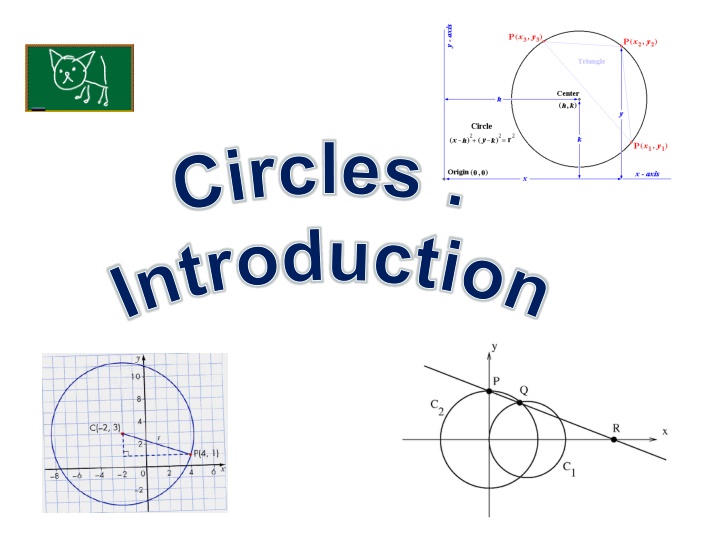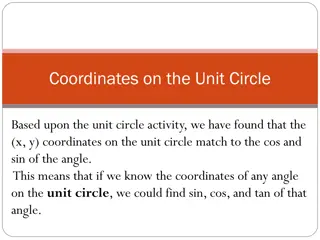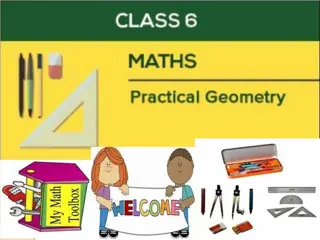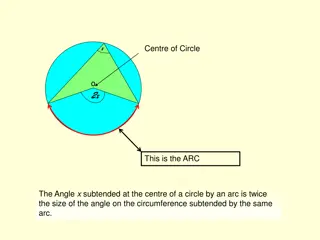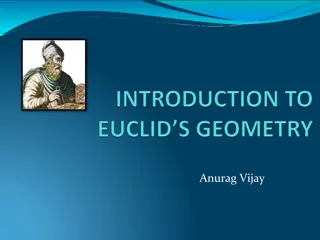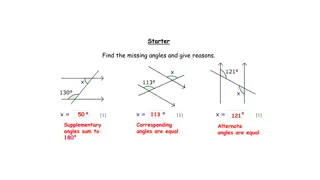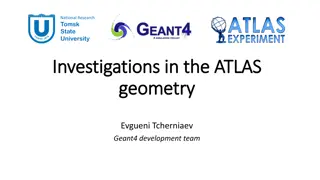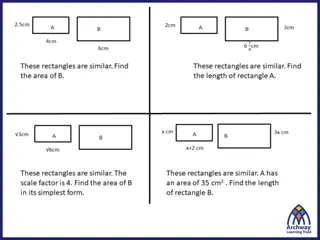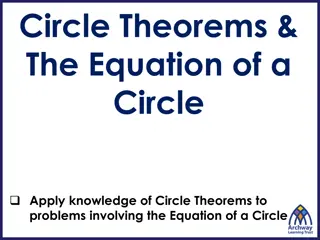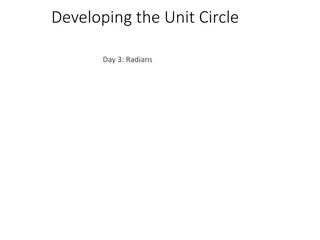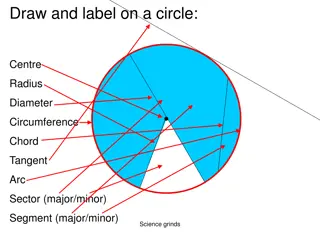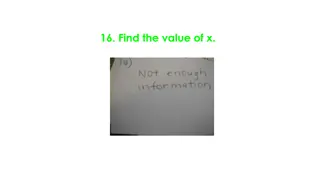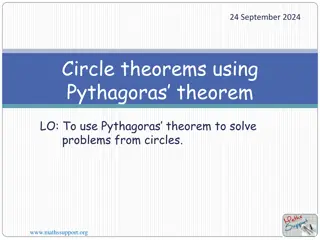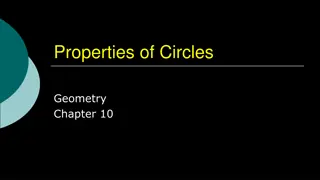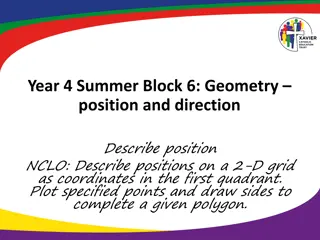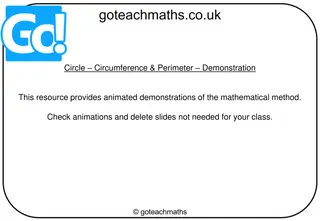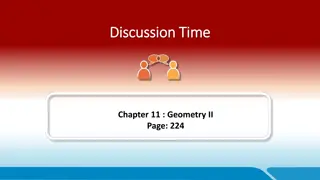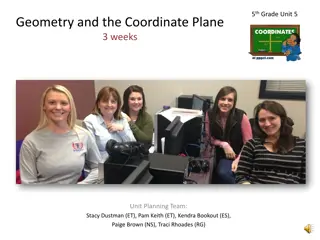Circle Geometry: Introduction and Problem Solving
This content explores circle geometry concepts such as finding midpoints, distances, center coordinates, and radius of circles. It includes examples, formulas, and practice problems to enhance understanding and problem-solving skills in circle geometry.
Download Presentation

Please find below an Image/Link to download the presentation.
The content on the website is provided AS IS for your information and personal use only. It may not be sold, licensed, or shared on other websites without obtaining consent from the author.If you encounter any issues during the download, it is possible that the publisher has removed the file from their server.
You are allowed to download the files provided on this website for personal or commercial use, subject to the condition that they are used lawfully. All files are the property of their respective owners.
The content on the website is provided AS IS for your information and personal use only. It may not be sold, licensed, or shared on other websites without obtaining consent from the author.
E N D
Presentation Transcript
Circles : Introduction
Circle Geometry Introduction BAT Find midpoints and distances BAT Solve problems with circle geometry using midpoints and distances KUS objectives Starter: You can find the mid-point of a line by using the following formula: ?1+?2 2 , 2 ?1+?2 i.e. find the average of the x and y coordinates a) Find the midpoint of this pair of points: 2,3 ??? 6,9 b) Find the midpoint of this pair of points: 2?, 4? ??? 7?,8? c) Find the midpoint of this pair of points: 4, 2 ??? 4,3 2 9 2?,2? 0,2 2 4,6
Notes AB is a diameter of a circle, where A and B are the coordinates (-3,8) and (5,4) respectively. Find the coordinates of the centre of the circle. (-3,8) A (1,6) (5,4) B The centre of the circle is at the midpoint of its diameter
Notes Reminder: finding lengths PQ is a line. Given that P is (8,-5), and Q is (-4, 1) find the length of PQ (-4,1) Q What can we use to find distances? ( ) ( ) P 2 2 = + d x x y y 2 1 2 1 (8,-5) (8 4)2+( 5 1)2 ? = = 180 = 6 5
WB30ab The points (3, 4) and B (-1, 6) are the end points of a diameter of a circle a) Find the coordinates of the centre of the circle b) Find the radius of the circle Centre 1, 5 Radius= ( 1 3)2+(6 4)2 = 20 = 2 5
WB30cd PQ is a diameter of a circle, centre (2,-2). Given that P is (8,-5), c) find the coordinates of Q. d) Find the radius of the circle Write the unknown coordinate in terms of x and y, and fill in the formula for the mid-point as before ? + 8 2 ,? 5 2 (-4,1) (x,y) Q Set the x-part equal to 2 and the y-part equal to -2 ?+8 2 ? 5 2 = 2 (2,-2) = -2 (8,-5) P ? = 4, ? = 1 So Q is 4, 1 (2 4)2+( 2 1)2 = ?????? = 45 = 3 5
WB30ef The points A (4a,a) and B (-3a,2a) are the end points of a diameter of a circle . e) Find the coordinates of the centre of the circle f) Find the radius of the circle y (x2,y2) ? 2,3? Centre 2 ( ) ( ) (y2-y1) 2 2 = + a a 3 4 2 d a a (x2-x1) ( ) ( ) a (x1,y1) 2 2 = + 7 d a x = 2 50 d a = 2 50 d a = 5 2 d a Radius = 5a 2 2
( ) ( ) 2 2 = + d x x y y WB30gh 2 1 2 1 PQ is the diameter of a circle, where P and Q are (-1,3) and (6,-3) respectively. g) Find the centre of the circle h) Find the radius of the circle 5 2,0 Centre ( ) ( ) ( ) 2 2 = + 6 1 3 3 d ( ) 7 ( ) 2 2 = + 6 d d = 85 Radius = 85
WB31 The line AB is the diameter of the circle, where A and B are (-3,21) and (7,-3) respectively. The point C (14,4) lies on the circumference of the circle. Find the values of AB2, AC2 and BC2 and hence show that angle ACB is 90 ( ) ( ) ( ) ( ) 2 2 2 2 = + = + AB x x y y AC x x y y 2 1 2 1 2 1 2 1 (-3,21) A ( ) ( ) ( ) ( ) 2 2 2 2 = + = + 2 2 AB x x y y AC x x y y 2 1 2 1 2 1 2 1 ( ) ( ) ( ) ( ) ( ) ( ) 2 2 2 2 AB = + AC = + 4 21 2 2 3 7 21 3 14 3 (14,4) C AB = AC = 2 2 676 578 B ( ) ( ) 2 2 = + BC x x y y (7,-3) 2 1 2 1 ( ) ( ) 2 2 = + 2 BC x x y y 2 1 2 1 ( ) ( ) ( ) 2 2 BC = 14 7 + 2 4 3 Since Pythagoras Theorem works, ACB must be right-angled! BC = 2 98 578 98 + 2 AC = 676 2 = + 2 BC AB
WB32 The line AB is the diameter of the circle with centre C, where A and B are (-1, 4) and (5, 2) respectively. The line l passes through C and is perpendicular to AB. Find the equation of l. a) Find the gradient of the line AB b) Then work out the gradient perpendicular to that c) We also need to find the co-ordinates of the centre d) We can then find the equation of l l (-1,4) A 2 4 5 ( 1) = Gradient (5,2) B C 1 3 Gradient = + + ( ( 1) 5 4 2 2 ) Midpoint of AB = , 2 = 2) 6 ( ) y y y y y 3 3( = 3 3 = 3 x = m x x x 3 x Midpoint of AB = 2,3 1 1
The line PQ is the Chord of the circle centre (-3,5), where P and Q are (5,4) and (1,12) respectively. The line l is perpendicular to PQ and bisects it. Show that it passes through the centre of the circle. a) Find the midpoint of PQ b) Find the gradient of PQ, and then the perpendicular c) We can then find the equation of line l and substitute (-3,5) into it WB33 (1,12) + + ( 1 5 12 4 , 2 ) Midpoint of PQ = Q l 2 Midpoint of PQ = 3,8 C P 12 4 1 5 (5,4) (-3,5) = Gradient = Gradient 2 = ( ) y y m x 1 ( 2 x 1 1 = + 0.5 6.5 y x = 8 3) y x 5 0.5( 3) 6.5 = + 8 0.5 = 0.5 = 1.5 y y x 6.5 1.5 6.5 = + 5 + x
WB34 The lines AB and CD are chords of a circle. The line y = 3x 11 is the perpendicular bisector of AB. The line y = -x 1 is the perpendicular bisector of CD. Find the coordinates of the circle s centre. THE PERPENDICULAR BISECTOR OF A CHORD GOES THROUGH THE CENTRE! So: Set the bisectors equal to each other and solve the equation for x and y. y = 3x - 11 D = = 3 4 11 11 1 x x x = x = x 1 4 10 2.5 C y = 3.5 A B y = -x - 1
KUS objectives BAT Find midpoints and distances BAT Solve problems with circle geometry using midpoints and distances self-assess One thing learned is One thing to improve is
